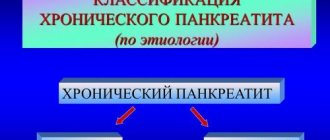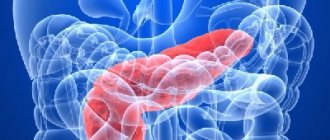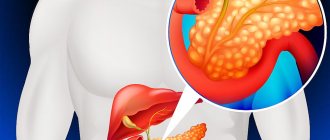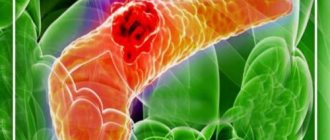Pancreatitis is inflammation of the pancreas.
The pancreas is the second largest gland in the digestive system (after the liver). It plays an extremely important role in the digestion process.
The pancreas produces pancreatic juice, which contains more than 30 different enzymes. It contains components necessary for the breakdown of fats, proteins, and carbohydrates. Up to 800 grams are produced daily. pancreatic juice, which flows through the pancreatic duct into the duodenum. To prevent the juice from corroding the tissue of the pancreas itself, enzymes are initially produced in an inactive form. To transform them into an active form and start the digestive process itself, it is necessary to interact with bile, which normally should occur in the duodenum. If bile enters the pancreatic duct or if the outflow of pancreatic secretions is obstructed, premature activation of enzymes occurs, which leads to the process of self-destruction of the pancreas. The gland begins to digest itself - tissue necrosis begins, pancreatitis occurs.
Causes of pancreatitis
In most cases, pancreatitis develops as a result of cholelithiasis (stones can obstruct the outflow of pancreatic secretions), or as a result of alcohol abuse.
Women at risk are during pregnancy and in the early postpartum period. Monotonous food, overeating and consumption of low-quality foods (including fast food) can also cause an attack of acute pancreatitis.
Other factors contributing to the development of pancreatitis include:
- diseases of the stomach and duodenum;
- tumors;
- injuries;
- parasites (worms);
- taking certain medications, such as furosemide, estrogens, antibiotics, sulfonamides;
- metabolic disease;
- hormonal changes;
- vascular diseases.
Most often the disease is registered between the ages of 40 and 60 years.
Pancreatitis in children
In young children, pancreatitis is usually a consequence of congenital malformations of the digestive system or enzyme deficiency. It can also be a complication of mumps (mumps). In older children, the development of the disease may be associated with poor nutrition (including abuse of sweets and carbonated drinks) or caused by intestinal parasites.
Children are often unable to clearly formulate their complaints, what and how they hurt. Therefore, at the first signs of the disease (the child’s complaints of abdominal pain, nausea, vomiting, unstable stool with impurities of undigested food), you should immediately consult a doctor. Infants with pancreatitis cry hysterically and quickly lose weight. Their tummy is swollen.
It is necessary to diagnose the disease promptly and begin treatment to prevent loss of the pancreas.
More information about pancreatitis in children
Symptoms
Acute pancreatitis is manifested by sudden pain in the upper abdomen. The pain often spreads in all directions - to the back or chest. Therefore, the disease can be confused with other acute abdominal diseases or a heart attack.
Depending on the severity of acute pancreatitis, the following symptoms are noted:
- Increased body temperature.
- Accelerated heartbeat.
- Pain in the upper abdomen and painful tightening of the abdominal muscles, often lasting several days. Patients take a sitting position or lie with their legs pressed to their stomach.
- Jaundice.
- Discoloration of stool.
- Shortness of breath, which may be caused by irritation of the diaphragm (due to inflammation), pleural effusion, or a more serious condition called respiratory failure.
- Sometimes there is muscle spasm in the extremities, secondary to decreased calcium levels in the blood.
Chronic pancreatitis is characterized by intermittent pain in the upper abdomen that lasts from several hours to several days. Eating fatty foods often causes digestive problems such as nausea, pain or vomiting.
Frequent symptoms of chronic inflammation of the pancreas:
- weight loss;
- excessive gas formation in the intestines;
- nausea and vomiting;
- diarrhea;
- attacks of severe hunger;
- weakness, irritability and decreased performance;
- jaundice.
In the end stage, the pancreas is severely damaged. However, victims, despite the progressive destruction of the organ, may not experience pain in the asymptomatic phases.
Attention! If the above symptoms appear, urgent consultation with a doctor is required. It is important to identify the disease early and prescribe effective treatment to prevent serious complications. An appointment with a gastroenterologist can be made by phone: +7 (4912) 57-50-48.
Symptoms of pancreatitis
The main symptom of pancreatitis is severe pain. Along with it, nausea, vomiting, a slight increase in temperature, flatulence, stool disorders and some other symptoms may be observed.
Abdominal pain
The main symptom of acute pancreatitis is severe pain, which usually begins in the left side and then becomes encircling. The pain is not relieved either by antispasmodics (“no-spa” and analogues) or by painkillers (analgesics). Lying on your back may intensify. An attack of pain with pancreatitis is usually observed after eating or drinking alcohol. When eating against the background of pain, the pain intensifies.
Vomit
The onset of acute pancreatitis may be accompanied by bouts of vomiting. Vomit with pancreatitis usually contains bile. During this period, you must completely stop eating.
More about the symptom
Temperature
During an attack of pancreatitis, the temperature may rise to 37.5°C.
More about the symptom
Flatulence
The attack disrupts intestinal motility. This leads to bloating.
More about the symptom
Stool disorder
The lack of necessary enzymes does not allow food to be properly digested, which causes stool upset.
Methods for diagnosing pancreatitis
The greatest difficulty is in diagnosing chronic pancreatitis.
.
Chronic pancreatitis often develops as an independent disease, and not as a complication of acute pancreatitis. At the same time, it is better to start treatment of chronic pancreatitis at an early stage, without leading to acute attacks.
For timely detection and diagnosis of chronic pancreatitis, it is necessary to undergo an annual preventive examination, as well as consult a gastroenterologist at the first suspicion of the disease.
The following diagnostic methods can be used to diagnose pancreatitis:
General blood analysis
A general blood test for pancreatitis reveals an increase in leukocytes (tens of times), a significant increase in ESR.
More information about the diagnostic method
Blood chemistry
In pancreatitis, the main indicator of biochemical analysis is pancreatic amylase (its level increases tenfold during the disease). An increase in other pancreatic enzymes, glucose and cholesterol is also expected.
More information about the diagnostic method
Biochemical urine analysis
In the case of pancreatitis, an increase in a biochemical urine test such as disstase (alpha-amylase) should be expected. The most indicative analysis of fresh urine (in CITO mode).
More information about the diagnostic method
Stool examination
For pancreatitis, a stool examination (coprogram) is performed. The study determines the degree of indigestion of food, as well as the ratio of digestive enzymes. Bacteria can be identified that have multiplied as a result of disruption of the intestines and the accumulation of food debris in it.
Ultrasound
Ultrasound of the pancreas allows you to confirm the diagnosis (detect an inflammatory process in the pancreas). Using ultrasound, you can evaluate the size of the pancreas, the condition of its tissue and ducts.
More information about the diagnostic method
X-ray of the abdominal cavity
X-rays can detect stones in the pancreas and its ducts. Currently, the preferred research method is computed tomography of the abdominal organs.
More information about the diagnostic method
MSCT of the abdominal cavity
Computed tomography of the abdominal cavity can identify complications of pancreatitis - such as stones, cysts and tumors (benign or malignant), and damage to neighboring organs.
More information about the diagnostic method
Magnetic resonance imaging (MRI)
MRI is the most informative method for examining the pancreas in cases of suspected pancreatitis. The method makes it possible to detect chronic pancreatitis in the early stages, even before the appearance of changes in soft tissues. Using MRI, differential diagnosis of chronic and acute pancreatitis is possible.
More information about the diagnostic method
Gastroscopy
Gastroscopy for pancreatitis makes it possible to assess the involvement of the stomach and duodenum in the pathological process. In some cases, gastroscopy can be used to determine what triggered the development of acute inflammation.
More information about the diagnostic method
Sign up for diagnostics To accurately diagnose the disease, make an appointment with specialists from the Family Doctor network.
What happens if pancreatitis is not treated?
In chronic pancreatitis, damaged pancreatic tissue turns into fluid-filled chambers called pseudocysts that become inflamed and bleed. In the bile duct system, constrictions and stones gradually form, which prevent the discharge of secretions and contribute to the accumulation of digestive juices.
If the damage is already very advanced, it can lead to pancreatic cancer, diabetes, liver damage and intestinal dysbiosis. At the terminal stage, peritonitis and intestinal lesions sometimes develop.
Pancreatitis cannot be overcome with folk remedies or other types of self-medication. For any of the above symptoms, you must visit a therapist or gastroenterologist to undergo a comprehensive diagnosis and prescribe effective treatment. Modern diagnostic methods help detect inflammation of the pancreas at an early stage.
Attention!
If after a festive feast or drinking alcohol you feel flatulence, nausea, or diarrhea, then you should contact the specialists at SM-Clinic. A highly qualified gastroenterologist with many years of experience will examine you, prescribe tests and help eradicate the cause of your symptoms. All services are provided at the highest level, and advanced medical equipment is used. We work 7 days a week. Don't endure the pain - call!
Treatment methods for pancreatitis
In the absence of proper treatment, pancreatitis can become chronic, manifesting itself in the form of exacerbations (symptoms of chronic pancreatitis during an exacerbation are similar to the symptoms of acute pancreatitis). The development of complications such as atrophy, fibrosis, calcification of the pancreas, and pancreatic necrosis is possible. Such complications can be fatal.
Under no circumstances should you self-medicate pancreatitis. In addition to the risk of complications, it is worth considering that you cannot focus only on your own interpretation of pain. Similar pain can be caused not only by pancreatitis, but also by other reasons. Pancreatitis must be diagnosed by a doctor.
In case of acute pain, you should call an ambulance.
Treatment of acute pancreatitis
carried out in a hospital.
Treatment of chronic pancreatitis
aimed at restoring pancreatic function. If seeking medical help was timely, then a fairly rapid restoration of the functions of the pancreas in full is possible.
The course of treatment includes:
Diet correction
Treatment of chronic pancreatitis includes the appointment of a special diet, which involves the exclusion of spicy and fatty foods, alcohol, and a low carbohydrate content.
Drug treatment
During the period of restoration of pancreatic function, medications containing pancreatic enzymes are prescribed.
Treatment of cholelithiasis
A factor contributing to the development of pancreatitis is, for example, cholelithiasis. Therefore, treatment of chronic pancreatitis includes measures to treat this disease (removal of the gallbladder).
Make an appointment Do not self-medicate. Contact our specialists who will correctly diagnose and prescribe treatment.
Rate how useful the material was
thank you for rating
Acute pancreatitis: prevent and neutralize
There are many causes of abdominal pain. One of the most serious illnesses accompanied by pain is acute pancreatitis. Despite the modern state of medicine, this pathology, if not treated in a timely manner, can lead to the development of serious complications and even death.
We talked about this disease with the surgeon at the Expert Clinic Smolensk, Efim Semenovich Asnin.
— Efim Semyonovich, in October 2016, the public was shocked by the news of the death of the Minister of Health of Lithuania. A young 35-year-old politician died of pancreatitis. What kind of disease is this and how dangerous is it?
Pancreatitis is inflammation of the pancreas tissue. Normally, this organ produces, among other things, digestive enzymes, which are released into the lumen of the duodenum through special ducts. For some reason, these ducts may overlap. As a result, enzymes do not enter the intestines and begin to “digest” the gland tissue. Pancreatitis develops.
THE CONSEQUENCES OF ACUTE PANCREATITIS MAY BE, IN PARTICULAR, FORMATION OF CYSTS, DEADNESS OF GLAND TISSUE, FORMATION OF UPRESSURES IN IT
Depending on the course, it can be acute, chronic, or hidden.
The consequences of acute pancreatitis can be, in particular, the formation of cysts, necrosis of gland tissue, and the formation of ulcers in it.
— What are the symptoms of acute pancreatitis?
These are signs such as:
- severe pain in the upper abdomen, which can be girdling. Sometimes the pain is diffuse, so the patient does not immediately understand what and where exactly is bothering him;
- pain can radiate to the lower back, kidneys;
- increased body temperature, chills;
- skin is pale, with an earthy tint;
- bad breath;
- shortness of breath;
- surges in blood pressure (both increase and decrease);
- nausea, as well as indomitable vomiting, which does not bring relief;
- bloating;
- possible belching, heartburn, diarrhea;
- there may be particles of undigested food in the stool, it may turn green and have an unpleasant odor;
- deterioration of the patient’s condition as the inflammatory process in the gland progresses. This is a rapid process, which may result in a transition to a chronic form or its aggravation (for example, necrosis of gland tissue).
IF SIGNS OF PANCREATITIS SHOULD SEEK IMMEDIATE MEDICAL CARE
It should be remembered that the signs that occur in acute pancreatitis can also be observed in a number of other diseases. In any case, you should seek medical help immediately.
“Pathologies of many organs, in addition to the digestive system and the abdominal cavity as a whole, can be accompanied by pain.” Quote from the material “Insidious pain-mask. Does abdominal pain always indicate problems with the gastrointestinal tract?
— What is the right thing to do if you discover signs of acute pancreatitis in yourself or your loved ones?
First aid and tactics are as follows:
- do not take any food;
- lie down;
- apply cold to the epigastric area;
- Call an ambulance immediately.
You should not take any painkillers or other medications. You can take an antispasmodic - in particular, no-shpu, drotaverine in a therapeutic dose (subject to their tolerance).
— How is acute pancreatitis diagnosed?
Only in a hospital setting. The patient is interviewed and examined by the doctor.
The following studies are assigned:
- blood, urine and stool tests;
— Ultrasound of the pancreas;
- plain radiograph of the abdominal cavity;
— CT, MRI;
- according to indications - also fibrogastroscopy, laparoscopy.
— Despite the complexity of this disease, is modern medicine able to effectively treat patients with acute pancreatitis?
The effectiveness of treatment and prognosis critically depend on the speed of contacting a doctor: the sooner, the better! It is important to remember that acute pancreatitis today remains a serious disease that can result in the death of the patient. Therefore, you should seek medical help without delay.
THE EFFECTIVENESS OF TREATMENT AND PROGNOSIS CRITICALLY DEPEND ON THE SPEED OF CONTACTING A DOCTOR: THE EARLIER THE BETTER!
— Efim Semyonovich, why does acute pancreatitis develop? What leads to the development of this disease?
Among the causes and predisposing factors:
- food or alcohol poisoning (or if it is high-quality alcohol, but consumed even in small quantities and regularly);
- overeating;
- fatty and spicy foods;
- consumption of out-of-season vegetables and fruits containing pesticides and chemical additives;
- injuries of the anterior abdominal wall with contusion of internal organs, penetrating wounds in this area;
— undergone operations during which the pancreas could have been accidentally affected;
— pathologies of the biliary tract, gall bladder, stomach, intestines;
- arterial hypertension;
- diabetes;
- any circulatory disorders in the abdominal cavity;
- pregnancy;
- taking certain medications, chemicals.
— Under what conditions can acute pancreatitis become chronic?
If the factors I have listed to some extent, little by little, affect a person, and at the same time he does not go to the doctor (according to the principle “if it hurts, it goes away”), pancreatitis can become chronic.
— How does chronic pancreatitis proceed? Are there any differences in manifestations?
The course of the disease in chronic pancreatitis is characterized by veiled, “blurred” symptoms that occur during its acute course. They can disappear and appear.
— Is it possible that the clinical picture is erased and a person does not even suspect that he has pancreatitis?
Yes. In addition, this can happen with alcohol intoxication or taking painkillers.
— How to avoid problems with the pancreas and prevent the development of acute pancreatitis? Tell us about the prevention of this disease
This is, first of all, rational nutrition and diet. The intake of alcoholic beverages is limited; fatty, fried, spicy foods; strong coffee and tea; sour fruits and vegetables - especially on an empty stomach. Heavy physical activity, injuries, and smoking should be avoided.
If you suspect chronic pancreatitis, you must also follow a diet. You should completely exclude fried foods, mushrooms, pork, lamb, offal, lard, butter, pasta (vermicelli is allowed). You cannot drink alcoholic beverages, strong coffee, chocolate, cocoa, baked goods, cakes, fresh bread, or sweets.
“Festal and Mezim are considered representatives of the old generation of enzymes; more modern drugs are used instead.” Quote from the material “How to survive the New Year holidays without health consequences?”
The basis of the diet is cereal and vegetable dishes, boiled (boiled), stewed, with a minimum of oil.
While eating, you should take modern enzyme preparations.
If there are intestinal disorders, probiotics can be prescribed to restore the intestinal microflora.
All questions about dietary habits and medications should be discussed with your doctor.
Other materials:
Gallstone disease: symptoms, diagnosis, treatment
Is it possible to cleanse the liver?
At an appointment with a nutritionist. Soup: is it good or bad?
For reference:
Asnin Efim Semenovich
In 1972 he graduated from the medical faculty of the Smolensk State Medical Institute (today - Smolensk State Medical University), in 1973 - an internship in surgery.
He underwent advanced training in various areas of surgery and orthopedics.
Doctor of the highest category.
Works as a surgeon at the Expert Clinic Smolensk. Receives at the address: st. March 8, no. 20.









